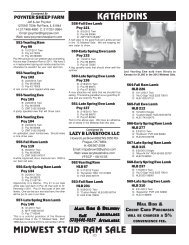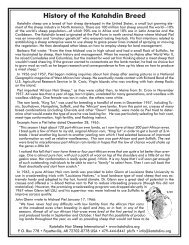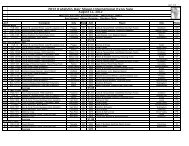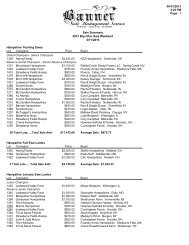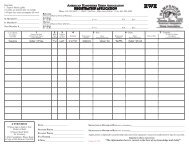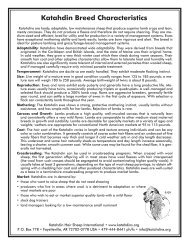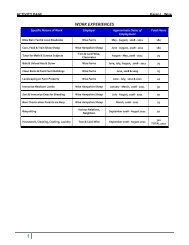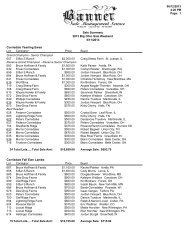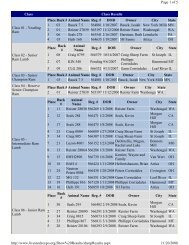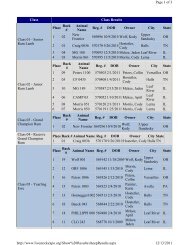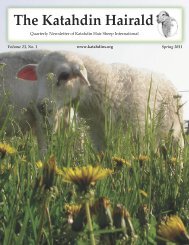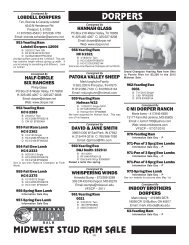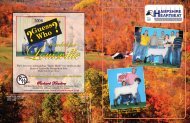KHSI Hairald Summer 2007
KHSI Hairald Summer 2007
KHSI Hairald Summer 2007
Create successful ePaper yourself
Turn your PDF publications into a flip-book with our unique Google optimized e-Paper software.
ROTATIONAL GRAZING & MANAGING PARASITES, CONTINUED FROM PAGE 13<br />
grazed below 2 inches will result in<br />
more forage growth and decreased<br />
worm ingestion by the sheep, a winwin<br />
situation.<br />
There are several practices that<br />
the shepherd can use to minimize<br />
grazing below 2 inches. Use smaller<br />
paddocks with frequent inspections<br />
to monitor forage height. Evaluate<br />
forage stands and design the shape<br />
of the paddock so that forage species<br />
composition is even—this results in<br />
more even grazing. A paddock that<br />
is similar in forage composition<br />
throughout is significantly easier to<br />
manage than one that has fescue in<br />
one region, warm season annual in<br />
high density in another and more<br />
clover in a third area.<br />
Smaller paddocks require more<br />
labor, more frequent moves and<br />
increased fencing expenses. The increased<br />
labor and expense can pay<br />
if the sheep flock is perennially challenged<br />
by parasites and mortality<br />
and/or weight gains are significant.<br />
Reducing a 5-15% mortality rate and<br />
10-30% decrease in growth in lambs<br />
for a few months every year can be<br />
a great payback for extra money<br />
and time Also, improved grazing<br />
control enables the grass producer<br />
to increase forage production.<br />
To control parasites, areas that<br />
receive frequent grazing pressure<br />
should also receive attention:<br />
watering tanks, lanes for moving<br />
animals, night corrals, supplemental<br />
feeding areas and shade areas.<br />
Besides having short forage height<br />
from repeated grazing, these areas<br />
have more fecal deposition and thus<br />
much higher densities of worm larvae<br />
than other regions of the paddocks.<br />
More or movable watering<br />
tanks, movable shade structures<br />
and changing supplemental feeding<br />
locations can decrease parasite<br />
exposure. Some parasitologists recommend<br />
using herbicides in high<br />
traffic areas, so that these high risk<br />
areas are not grazed.<br />
Besides minimizing grazing close<br />
to the ground, other management<br />
changes can decrease worm load.<br />
These can be applied to both continuous<br />
and rotational grazing. Any<br />
practice that a) decreases the density<br />
of sheep or b) decreases the number<br />
of days that highly susceptible sheep<br />
are on a paddock during the grazing<br />
season, especially during the peak<br />
parasite season, will decrease worm<br />
load. This can include alternating<br />
cycles of sheep grazing with cattle<br />
or horses or haying the paddock for<br />
one grazing cycle. The longer time<br />
between sheep grazing cycles will<br />
result in fewer eggs laid on pastures<br />
and thus less buildup of worm<br />
numbers in the paddock over the<br />
grazing season. Parasitologists also<br />
advise that cattle grazing and haying<br />
a paddock decrease the total of<br />
worms and cause worm death. Haying<br />
can dry out the soil surface and<br />
kill worm larvae, and cattle ingestion<br />
of sheep worm larvae has been<br />
shown to kill most of the ingested<br />
larvae. Other management systems<br />
that annually rotate two or more of<br />
the following - cattle, sheep, haying<br />
and cropping - can decrease or kill<br />
all larvae on the pasture.<br />
Decreasing the numbers of<br />
susceptible young lambs and lactating<br />
ewes on a paddock during<br />
the warmer humid months can be<br />
changed by a) lambing in the fall<br />
or early spring, b) selling some or<br />
all lambs at weaning instead of<br />
later in the season and c) selecting/<br />
purchasing more parasite resistant<br />
sheep. A key to understanding the<br />
worms and sheep is thinking of<br />
parasites as a density-based disease.<br />
Any practice that decreases<br />
the density of the most susceptible<br />
animals during the peak parasite<br />
season will decrease pasture worm<br />
load this year and next year.<br />
In summary, rotational grazing<br />
won’t eliminate worm-parasite issues<br />
in sheep. But any controlled<br />
grazing practice that minimizes<br />
the amount of forage ingested that<br />
is less than 2 inches in height OR<br />
decreases the density of highly susceptible<br />
animals during the risky<br />
parasite months are all predicted to<br />
decrease mortality and/or performance<br />
losses.<br />
Are Your Registered &<br />
Recorded Katahdins<br />
Correctly Identified?<br />
By <strong>KHSI</strong> Operations<br />
Katahdins that have <strong>KHSI</strong> certificates<br />
of registration or recordation<br />
must be permanently identified with<br />
the proper ID to be in compliance<br />
with the <strong>KHSI</strong> Registry. What does<br />
this include? Proper ID means a<br />
readable tattoo or ear tag. The tag<br />
or tattoo must match the “Animal<br />
ID” that is on the certificate. The<br />
tattoo or ear tag must include the<br />
prefix. If the ID on the animal is<br />
not permanent, does not have the<br />
<strong>KHSI</strong> prefix, and does not exactly<br />
match the Animal ID that is on the<br />
<strong>KHSI</strong> certificate, then the animal is<br />
out of compliance with the <strong>KHSI</strong><br />
Registry. Collar tags are not considered<br />
permanent ID. The most<br />
common errors we hear about are no<br />
prefix on the tag or that the tag has<br />
been replaced by a different number<br />
that does not match the certificate.<br />
Replacement and/or original tags<br />
may be handwritten on a blank tag<br />
with a designated tag marking pen.<br />
Check handwritten tags regularly to<br />
be sure they remain legible. Thank<br />
you for your help.<br />
Need sheep<br />
transportation<br />
from the Expo?<br />
Contact Jim Morgan,<br />
479-444-8441,<br />
khsint@earthlink.net<br />
Page 14 The Katahdin <strong>Hairald</strong> • www.<strong>KHSI</strong>.org SUMMER <strong>2007</strong>



